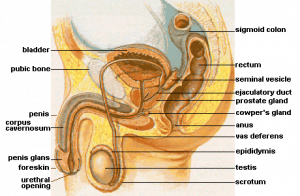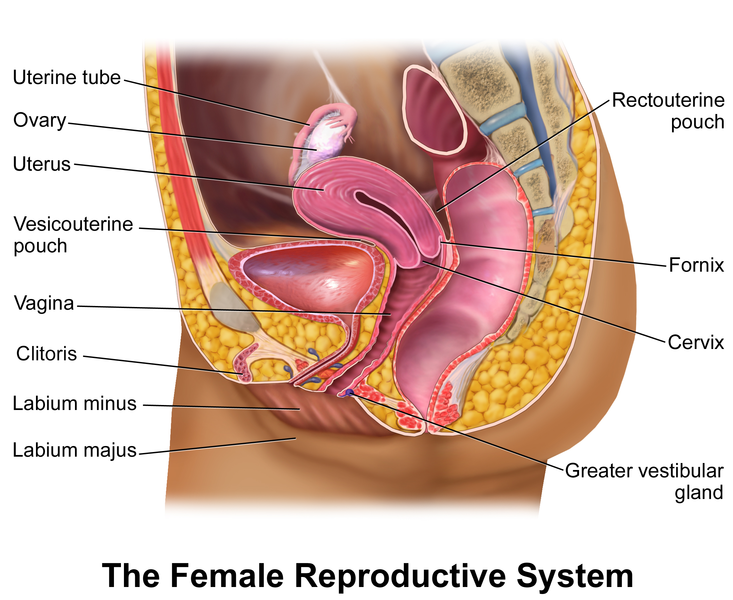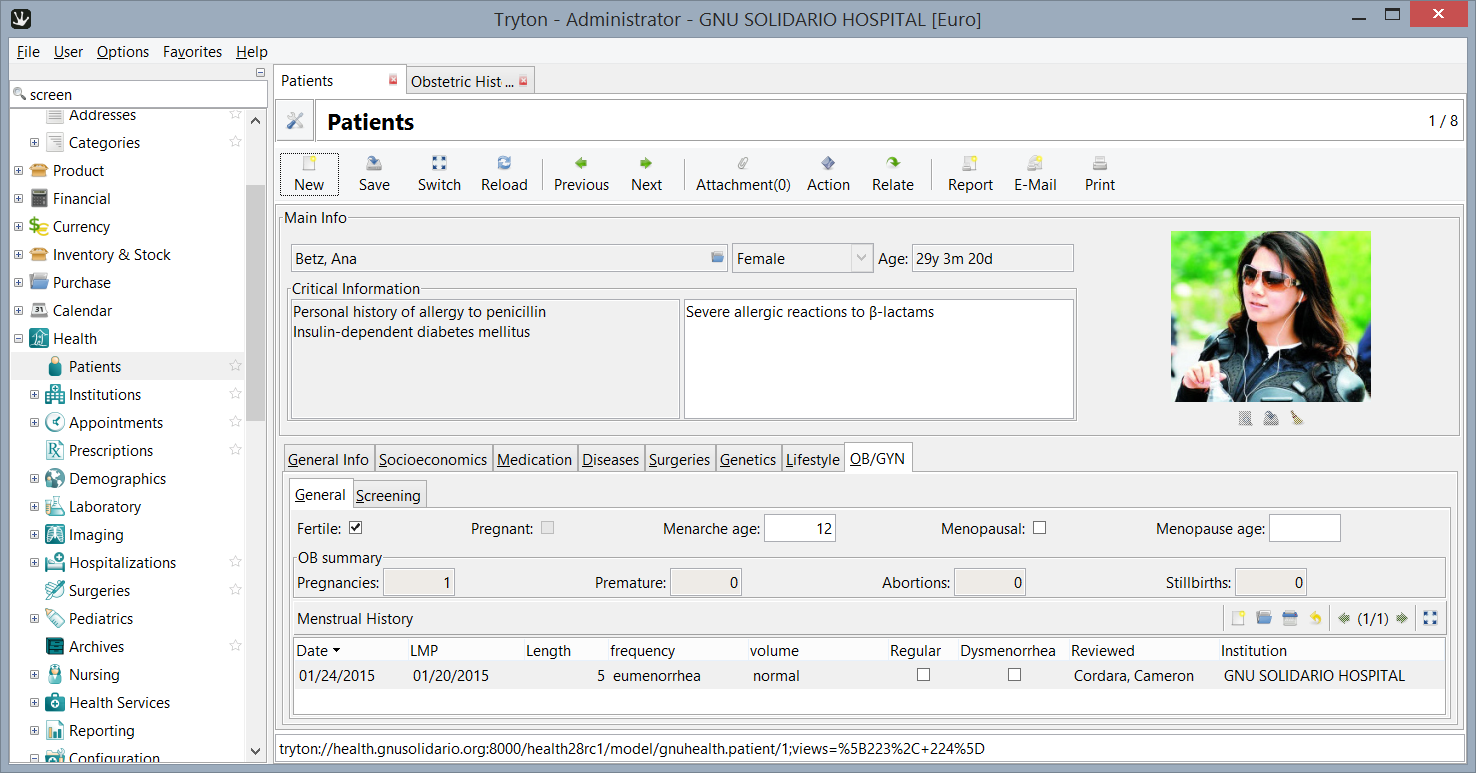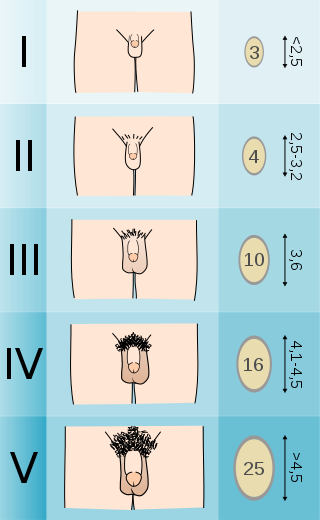16 Focused Assessment: Reproductive Assessment
Learning Objectives
At the end of this chapter, the learner will:
- Obtain the health history related to the male and female reproductive systems, practices, and problems.
- Educate the patient on what to expect during the performance of the physical assessment of the male and female internal and external genitalia.
- Discuss the ethical-legal aspects of the reproductive assessment.
- Act as a patient advocate by being present during the female gynecology (GYN) exam
- Document the assessment findings discussed with the patient, the patient’s response to information shared, and the need for follow-up
I. Overview of the male and female male reproductive Systems
Adolescence is a period that begins with puberty and ends with the transition to adulthood (approximately ages 10–20). Physical changes associated with puberty are triggered by hormones. Cognitive changes include improvements in complex and abstract thought, as well as the development that happens at different rates in distinct parts of the brain and increases adolescents’ propensity for risky behavior because increases in sensation-seeking and reward motivation precede increases in cognitive control.
Sexual Development
Initially, there is a growth spurt, followed by the first part of sexual maturity where primary sexual characteristics develop and changes to the internal reproductive organs occur.
- For males, there is growth to the testes, penis, scrotum, and spermarche or the first ejaculation of semen occurs. This occurs between 11 and 15 years of age.
- For females, the uterus grows and menarche or the first menstrual period occurs. The female gametes, which are stored in the ovaries, are present at birth but are immature. Beginning at puberty, one ovum ripens and is released about every 28 days during the menstrual cycle. Stress and a higher percentage of body fat can bring menstruation at younger ages.
The second part of sexual maturity occurs with the visibility of secondary sexual characteristics. These are physical changes not directly linked to reproduction, but signal sexual maturity.
- For males, this includes broader shoulders and a lower voice as the larynx grows. Hair becomes coarser and darker, and hair growth occurs in the pubic area, under the arms, and on the face.
- For females breast development occurs around age 10, although full development takes several years. Hips broaden and pubic and underarm hair develops and also becomes darker and coarser.
Cultural differences are noted with African American girls enter puberty the earliest, followed by Hispanic girls, then European-American, and lastly Asian-American girls. Although African- American girls are typically the first to develop, they are less likely to experience negative consequences of early puberty when compared to European-American girls (Weir, 2016).
Tanner Scale of secondary sex organs by age for males and females
The Tanner staging scale is also known as the Sexual Maturity Rating (SMR) chart. This is an objective classification system used by Pediatricians and other health care providers to track and document the development of a patient’s secondary sex characteristics as these change from those of a child through puberty to those of an adult.
https://en.wikipedia.org/wiki/Tanner_scale
II. Anatomy and Physiology
Male Reproductive System:
Males have both internal and external genitalia that are responsible for procreation and sexual intercourse. Males produce their sperm on a cycle, and unlike the female’s ovulation cycle, the male sperm production cycle is constantly producing millions of sperm daily. The main male sex organs are the penis and the testicles, the latter of which produce semen and sperm.

Male anatomy with secondary sex characteristics.
Click on this link to watch the video on the male reproduction system if the video is not present:
Female external genitalia is collectively known as the vulva, which includes the mons veneris, labia majora, labia minora, clitoris, vaginal opening, and urethral opening. Female internal reproductive organs consist of the vagina, uterus, fallopian tubes, and ovaries. The uterus hosts the developing fetus, produces vaginal and uterine secretions, and passes the male’s sperm through to the fallopian tubes while the ovaries release the eggs. The vagina is attached to the uterus through the cervix, while the uterus is attached to the ovaries via the fallopian tubes.
Female Reproductive System:


Click on this link to watch the video on the male reproduction system if the video is not present:
Knowledge Check
III. Medical Terminology:
| Amenorrhea | Absent menstrual cycle |
| Anus | The end of the gastrointestinal tract from which waste is expelled. |
| Cervix | The long narrow end of the uterus extending into the vagina. |
| Clitoris | “A small, sensitive, erectile part of the female genitals. |
| Circumcision | Surgical removal of the penis’ foreskin |
| Endometrium | The innermost lining of the uterus |
| Endometriosis | Endometrial tissue found outside the uterus. |
| Episiotomy | Surgical incision made into the perineum during delivery of the baby. |
| Estrogen | Female sex hormone that triggers the secondary sex characteristics. |
| Fertilization | The formation of a zygote when the egg and sperm combine. |
| Foreskin | “The retractable roll of skin covering the end of the penis.” |
| Gamete | One germ cell unites with another of the opposite sex to form a zygote.” |
| Glans penis | The head of the penis. |
| Hysterectomy | Surgical removal of the uterus. |
| Hymen | Membrane at the vagina opening. |
| Labia minora | A thin part of the vulva that protects the clitoris and vaginal orifice |
| Labia majora | Protects vagina-produces lubricating secretions via sweat and sebaceous glands. |
| Luteinizing hormone (LH) | A second female hormone that assists with ovulation. |
| Mammograms | Special x-ray/ultrasound of breast tissue that detects breast cancer. |
| Menstrual Cycle | The shedding of endometrium when fertilization has not occurred. |
| Menopause | Occurs when women no longer menstruate from aging, medications, or surgery |
| Moms pubis | External female genitalia |
| Oophorectomy | Surgical removal of the ovaries |
| Ovaries | Create and house the ovum. |
| Ovulation | The mature ovum(egg) is released from the ovary
|
| Pap Smear | Cervical cells are collected by scraping the cervix at the outer opening and the endocervix allowing microscopic visualization and the ability to detect abnormal cells quickly.
|
| Penis | External male genitalia is used for urination and reproduction. |
| Prepuce | The skin/area between the vulva and the anus. |
| Prostate gland | Produces seminal fluid. |
| Rectum | The end of the gastrointestinal tract from which waste is expelled. |
| Seminal vesicle | Produces substances that nourish and protect sperm to facilitate fertilization. |
| Scrotum | A pouch that contains the testes |
| Testes | Produces and houses sperm |
| Uterus | The expandable tube supports the embryo and placenta during pregnancy |
| Ureteral meatus | The terminal part of the urinary tract from which urine flows |
| Vas Deference | The tube that transports sperm to the urethra prior to ejaculation |
Knowledge Check
IV. Step by Step Assessment
- Perform hand hygiene.
- Introduce yourself to the patient.
- Confirm patient ID using two patient identifiers (e.g., name and date of birth).
- Explain the process to the patient.
- Use appropriate listening and questioning skills.
- Listen and attend to patient cues.
- Ensure patient’s privacy and dignity.
- Apply principles of asepsis and safety.
- Check vital signs.
Conduct a focused reproduction system health history:
- Present complaint.
- History of chief complaint.
- Menstrual history: Age of Menarche? Last Monthly Period (LMP)? Any changes or pain related to menstruation?
- Past Gynecological history: Age at which puberty begins/began? How old was the patient when the first sexual encounter occurred and how many sexual partners has the patient had? Sexual history and if sexually active what type of contraception is being used? Acute or chronic diseases related to the reproductive system including Sexually Transmitted Infection (STIs)? Personal history of reproductive problems? Menopause: At what age did menses slow, become irregular, or stop? What symptoms are occurring? How are the menopausal symptoms being treated? Is there vaginal dryness or irritation? Is Estrogen Replacement Therapy being used? Is there any spotting or bleeding?
- Obstetrics History: The number of pregnancies and births. Type of delivery for each birth? Any complications from pregnancy, delivery, or postpartum.
- Past Medical, Surgical, and Social histories.
- Family history of reproductive problems including infertility, complications during birthing, and genetic or congenital diseases.
- Medication and Drug history.
- Nutritional history: malnutrition and some diet-related diseases e.g. Iron deficiencies can cause fatigue and low libido.
- Personal History: Reproductive wellness check: How often are external and internal genitalia assessed by a health care provider? How often is the patient performing self-assessment of breast, female or male genitalia? Female Problem History: Any pain or tenderness with ovulation, pre, during, or post menses (period), during or after sex? Any new lesions to external or internal genitalia? Any history of abnormal breast exams, pelvic exams, or Pap smears? Any new vaginal discharge, or itching? Any spotting or bleeding between menstrual periods? Any burning or irritation with urination? Any rectal lesions, warts, hemorrhoids, or bleeding? Any mood, psychological or behavioral changes noted pre, during, or post menses? Male Problem History: Any new lesions or masses to external genitalia? Any new penile discharge, or itching? Any difficulty, hesitancy, urgency, or burning with urination? Any difficulty with obtaining and maintaining an erection? Any history of Prostate problems including Benign Prostatic Hypertrophy (BPH) or disease? Any rectal lesions, warts, hemorrhoids, or bleeding?
- Breast History: Any breast tenderness of pain and for women is it associated with ovulation or menstruation? Any recent change in breast tissue or lumps palpated to breast or axillary-again for women is this associated with ovulation or menstruation? Any nipple discharge? Any axillary Tenderness? Any risk factors for breast cancer including Aging, genetic mutations, Menarche before 12 and menopause before 55, Dense breast, history of breast cancer or certain ono-cancerous diseases, family history of breast cancer, previous radiation therapy, and the use of the drug diethylstilbestrol.
Most of the questions listed above are now asked via a question sheet that is filled in while waiting to be seen by the Health Care Provider and the answers are reviewed and confirmed by the Health Care Provider when seen. Here is an example:
Obstetrics and Gynecology/Gynecological History Taking
 Martin Sauter, CC BY-SA 4.0 <https://creativecommons.org/licenses/by-sa/4.0>, via Wiki
Martin Sauter, CC BY-SA 4.0 <https://creativecommons.org/licenses/by-sa/4.0>, via Wiki
| Steps |
Additional Information |
| Pre-office visit | For females:
Schedule the appointment during the middle of the patient’s menstrual cycle. Inform the patient:
|
|
Assist the patient in completing a 24-hour diet recall to assess dietary intake and nutritional value of that intake.
Teach: Increased BMI increased the risk factors for uterine cancer. A High-fat diet increases the risk for breast, ovarian, and prostate cancer. Too little body fat in women will decrease estrogen levels. Calcium is needed at all ages but it is more important after menopause to prevent Osteoporosis |
|
2. Inspect:
|
The data obtained will enable the nurse to assist the patient as needed, avoid falls and maintain a safe and clean environment. |
|
3. Preparing the female patient for the GYN exam |
The GYN physical:
Let the patient know that the nurse will be with them as a chaperone at all times. Inform the patient that there will be an inspection and palpation of the breast which will include assessing lymph nodes above and below the scapula and under the arm and arm pt. Inspection and palpation of the external genitalia. Inspection of the internal genitalia with the aid of a speculum. Palpation of the pelvic, abdominal, and anal area with completion of the Bimanual exam. This exam is completed by a provider. The nurse will lay out all needed supplies and be present for the exam. Here is a video that demonstrates some parts of the exam. Please note that this video visualizes abnormal findings also. Please click on the link if the video is not present.https://vimeo.com/111934771 Nurses are the advocate for the patient having a GYN exam. Therefore knowing the different techniques used within the exam is important. Edit this so it starts with minute 2. Here is the complete examination:
Once the exam is complete the patient will receive tissue to clean off excess lubrication and will be given privacy to dress. A conversation about the exam, findings, and any needed follow-up will occur with the provider and the nurse will come back to ensure all teaching is completed and to follow up on needed tests or screening recommended or ordered. |
|
4. Preparing the young male patient for the male genital exam |
The genital exam:
Let the male patient know that the provider will examine the external genitalia by inspecting the the groin area, penis, and scrotum. Let the male patient know that the penis and the testicles will be palpated. Review the following Youtube to observe the male genitalia exam. Note this exam is completed by a Health Provider and not a nurse. Please click on the link if video does not come up: https://vimeo.com/nctcfp/male-genital-exam-eng https://vimeo.com/nctcfp/male-genital-exam-eng See video on Testicular Cancer Self Exam to teach self about self testicular monthly check_https://youtu.be/UpDvx2GlBE0-Please copy and paste the link into a search engine. The link will not work as a real patient is used to demonstrate the technique.
|
|
6. Breast exam |
The breast exam should be completed at least once a year with a provider especially at 40 years old or earlier if at high risk. Self-breast exam screenings should occur monthly. While completing a self-breast exam focus on any new changes to breast tissue as in change in size, find a lump, a change in nipple direction from eversion to inversion, redness, to the skin, puckering of the breast, ore redness, scaliness to the nipple or new nipple discharge. It is recommended that self-breast exam are complete within the 7-10 day of a woman cycle approximately a week after her menses has ended.
Breast Cancer in Men is rare but according to the CDC 1 in 100 breast cancer patients is male. Breast Cancer Screening Guidelines for Women: https://www.cdc.gov/cancer/breast/pdf/breast-cancer-screening-guidelines-508.pdf See the video on Self Breast Exam below if the video is not visible please click on this link:https://vimeo.com/111931581 |
Note: Click all hyperlinks to access more details.
Ethical-legal aspects of the reproductive system assessment include physical, emotional, and psychological safety, privacy, HIPAA, laws governing new procedures to assist with conceiving, ethical and moral conflicts as it relates to abortion, Laws concerning the need for parental consent for birth control, and abortion. As nurses, we also need to be aware of the laws concerning the physical and sexual abuse of minors. Another consideration is the mindfulness of culture and religion when caring for the reproductive health of women who cannot be examined without a male relative in the room.
A more detailed overview of the different ethical-legal aspects of the reproductive system assessment will be available at:
Mobile Phones in Research and Treatment: Ethical Guidelines and Future Directions
Phones are not allowed in all care settings to protect patient privacy and enforce HIPAA and think about the invasiveness of the reproductive system.
V. Documentation of Assessment Findings
A sample of a SOAP note
SOAP Note for a 16-year-old female with a six-month history of heavy and painful menstruation.
S: Chief complaint (CC): ” I am having extremely heavy and painful periods.
History of Present Illness (HPI): for about 6 months now that has been getting progressively worse. It is relieved with a hot pad, rest, and Advil every four hours. It is aggravated with exercise and when my menses flow is heavy. I have changed 4 pads in the last 6 hours.
Past Medical History (PMH): Seasonal Allergies
Current Medications: Claritin 10 mg PO q am for allergies
Allergies: Penicillin which leads to her face swelling.
Psychosocial and Family History: Lives at home with grandparents, parents, and 3 siblings on the family plot. Mom has Migraines and Grandmother had Endometriosis for 25 years until Hysterectomy two years ago.
Social History/Habits: She is a B + student who is on the wrestling team and volunteers at the animal shelter every Saturday.
O: Temperature: 97 degrees Fraanheit; Pulse: 110 beats per minute; Respirations: 14 breaths per minute; Blood pressure: 124/62 mm Hg: Pulse Ox 96 % on R/A; Weight: 155 lbs and Height is 66 inches.
General: The patient is alert, oriented X4, ambulates without difficulty, and is cooperating well even though she is anxious and in pain.
Physical Exam: S1 and S2 without ectopy but tachycardic, lung sounds are clear bilaterally with regular, rate, rhythm, and depth, Abdomen is soft, non-distended and non-tender but guarding noticed throughout especially to lower abdominal quadrants. Pelvic Exam demonstrated tenderness with the bimanual exam.
Diagnostic: List results:
- Urine test-Urine is yellow, clear with urine specific gravity of 1.005 and pH of 5. Sample negative for proteins, glucose, hemoglobin, bilirubin, Ketones, Nitrites, Leukocyte, Leukocyte Esterase, and WBC. Therefore the urinalysis is negative (normal).
- Blood test: Complete Blood count (CBC ): Hemoglobin 8 & Hematocrit 24 indicating moderate to severe blood loss -Anemia. White blood cells and platelet count are within normal. The Comprehensive Metabolic Panel (CMP) values are within normal values. This means that Albumin, Blood Urea Nitrogen (BUN), Calcium, Carbon Dioxide (Bicarbonate), Chloride, Creatinine, Glucose, Potassium, Sodium, Total Bilirubin, Total Protein, Alanine Aminotransferase (ALT), Alkaline Phosphatase (ALP), Aspartate Aminotransferase (AST), are all within the normal range.
- Ultrasound of the Pelvis: To assess for Endometriosis is positive. Differential Diagnosis of Endometriosis by Ultrasound: A Rising Challenge
A: Endometriosis
P: 1) Diagnostic: Transvaginal Ultraound indicating Endometriosis
2) Treatment: Continue the hot pad, Advil, and rest as before but try and eat frequent small meals.
3) Education: A discussion about what Endometriosis is, its genetic link, and a CD to watch to understand the disease further.
4) Consultation, Collaboration, or Referral: A referral to Dr. Kown the community specialist on Endometriosis is given to the patient in front of her parents
5) Follow-up: A telephone follow-up to occur in a week to ensure that patient has contacted and has an appointment to see Dr. Kown and that she is feeling better. Also, need her to get a repeat CBC in a week to check on Anemia.
VI. Related Laboratory and Diagnostic Procedures/Findings
Examination of the male and female reproductive system will include the following test:
- Complete Blood Count (CBC) to assess for Anemia through blood loss or indicate any kind of bleeding or clotting problem or infections
- Basis Metabolic Pane: to assess hydration, electrolyte, kidney function, and glucose level. Here is an article to understand more about lab values: https://www.uofmhealth.org/health-library/tr6153
- Urine test- What Your Urine Says About You and Your Health Here is a great article for further understanding of the urinalysis test: https://www.ncbi.nlm.nih.gov/books/NBK557685/
- Pap Smear: to assess the cell on and around the cervix of the uterus for abnormal cells. Here is a great article for further understanding of the Pap Smear: https://www.mayoclinic.org/tests-procedures/pap-smear/about/pac-20394841
- Brest exam and a monthly self-examination to assess for changes in breast skin, shape, size, pain and lump, and changes to the nipple.
- The male patient- testicular and prostate checks. Testicular self-checks to check for changes in the feel of tissue.
A more detailed overview about Puberty is available on this link Puberty in girls and boys facts
A more detailed overview about Benign Prostatic Hypertrophy is available on this link https://en.wikipedia.org/wiki/Benign_prostatic_hyperplasia
A more detailed overview about Rick factors for Breast cancer: https://www.cdc.gov/cancer/breast/basic_info/risk_factors.htm
VII. Learning Exercises:
Exercises
VIII. Attributions and Reference
Stoppler, M., C. Puberty https://www.medicinenet.com/puberty/article.htm
Lansford, J., Lifespan Development. Module 7: Adolescence https://courses.lumenlearning.com/suny-lifespandevelopment2/chapter/introduction-to-adolescense/
Lally M., and Valentine-French, S. Lifespan Development. Sexual Development https://courses.lumenlearning.com/suny-lifespandevelopment/chapter/sexual-development/
Sexual Development https://courses.lumenlearning.com/suny-lifespandevelopment/chapter/sexual-development/
Tanner Scale https://en.wikipedia.org/wiki/Tanner_scale
Introduction to Adolescence https://courses.lumenlearning.com/suny-lifespandevelopment2/chapter/introduction-to-adolescense/
My First Time: A Girl’s Guide to Vising Her Gynecologist https://www.aoafamily.com/home/news-topic.php?newsid=195
Female reproductive sys, menstruation & fertilisation | How do organisms reproduce | Khan Academy https://youtu.be/bj-fF5cIVYk
Male reproduction system: https://vimeo.com/204303895
Performing the male genital exam_English Version https://vimeo.com/nctcfp/male-genital-exam-eng
The 5-minute Pelvic exam- https://vimeo.com/111934771
Breast Cancer Screening Guidelines for Women: https://www.cdc.gov/cancer/breast/pdf/breast-cancer-screening-guidelines-508.pdf
How Often Should Women Get a Breast Exam? https://www.toplinemd.com/breast-care-center-of-miami/blog/how-often-should-women-get-a-breast-exam/
Practices of Breast Self-Examination and Associated Factors among Female Debre Berhan University Students https://www.hindawi.com/journals/ijbc/2017/8026297/
The Ethical, Legal, and Social Issues Impacted by Modern Assisted Reproductive Technologies https://www.hindawi.com/journals/ogi/2012/686253/
Genetic Testing between Private and Public Interests: Some Legal and Ethical Reflections https://www.frontiersin.org/articles/10.3389/fpubh.2018.00008/full
The Possible Dangers of Prenatal Nonmedical Sex Selection in regard to in vitro Fertilization https://madridge.org/journal-of-womens-health-and-emancipation/mjwh-1000112.php
Mobile Phones in Research and Treatment: Ethical Guidelines and Future Directions https://mhealth.jmir.org/2015/4/e95/
University of Michigan Health Michigan Medicine. Comprehensive Metabolic Panel September 23, 2020 https://www.uofmhealth.org/health-library/tr6153
Mayo Clinic Staff. Patient care & Health Information Pap Smear https://www.mayoclinic.org/tests-procedures/pap-smear/about/pac-20394841
Female Anatomy https://commons.wikimedia.org/wiki/File:Blausen_0400_FemaleReproSystem_02.png


